You might have heard this already, but we are big fans of The Enneagram personality assessment. Read our excerpt below from Darling Issue 19 to find out your type…and if it’s not for you, that’s okay too! However, we feel most of you will get sucked into a major rabbit hole with this information, it’s pretty addictive. Enjoy!
_________________
As individuals, we are mysteries. Complex, full of wonder and full of the ability to change. But we still have preferences. We operate naturally within the world in patterns, and that means that, within reason, some things are predictable. I’m one of those people who admittedly loves (almost has an obsession with) personality assessments. They give us the ability to engage in a dialogue about the ways that we connect with one another. They offer a skill set to see people in a new light, to recognize one another’s differences, and to deepen our understanding of ourselves and ultimately one another. The Enneagram has origins in the esoteric teachings of the Desert Elders, a group of monks who lived in the wilderness in the third century, but the test we now know (and love) was first put together by Oscar Ichazo, who had the desire to teach a system of self-realization. The premise of the assessment is that human patterns of motivation and behavior can be mapped out.
Here are the basics: The Enneagram has categorized human behavior into nine types, and the theory is that we each emerge from childhood with one of these types dominating our personality. In other words, we are each born with a basic disposition, and this orientation determines how we interact and adapt during the formative years of our childhood. At its roots, the test attempts to clarify the relationship between essence and ego. In Ichazo’s words: “We have to distinguish between a man as he is in essence, and as he is in ego or personality.” The Enneagram rests on the idea that we are born in perfection and yet there are things in us that become distorted. So at its best, the Enneagram is an amazing tool to point us toward self-growth and healing.
One major aspect of this construct is that each type has a basic fear and a basic motivation. The assessment breaks down human behavior by evaluating what truly drives us. For example, type three (the Achiever) is driven by the desire to feel valuable and worthwhile. The underbelly of this desire—or the fear—is that they will feel worthless. It is very likely that as you dive into the “types,” you will identify with more than one. The theory, however, is that you have a “dominant” type and this disposition determines your actions and reactions to the world around you. It’s also important to note that the types are gender neutral, do not change, and you will not always identify with every aspect of your type because you are human and constantly in fluctuation.
The basic Enneagram diagram is a symbol: an ancient circle that maps the nine types as well as their “wings.” It also includes lines, which indicate association with other types that will either promote growth for you or what is termed “disintegration.” In essence, each main type has a “partner in crime” or a “best match ever.” If we are stressed, and don’t balance ourselves, we seem more like that “disintegrated” other number. If we are flourishing and mature, we add the other type’s qualities to our own. A healthy “one,” for example, adds aspects of a “seven” to themselves. An unhealthy “one” veers toward a “four” and so on.
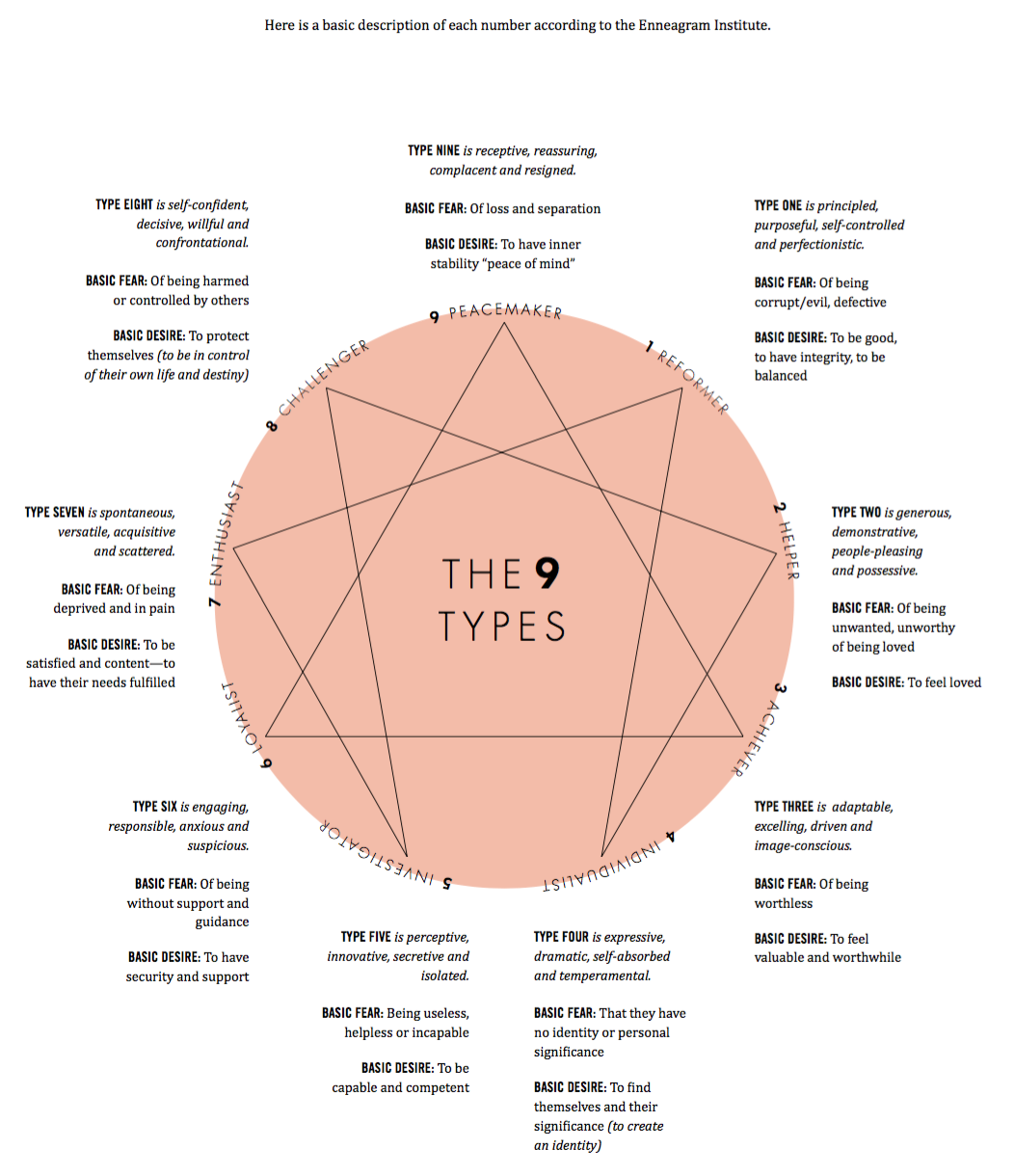
Here is a basic description of each number according to the Enneagram Institute.
Type One is principled, purposeful, self-controlled and perfectionistic.
- Basic Fear: Of being corrupt/evil, defective
- Basic Desire: To be good, to have integrity, to be balanced
Type Two is generous, demonstrative, people-pleasing and possessive.
- Basic Fear: Of being unwanted, unworthy of being loved
- Basic Desire: To feel loved
Type Three is adaptable, excelling, driven and image-conscious.
- Basic Fear: Of being worthless
- Basic Desire: To feel valuable and worthwhile
Type Four is expressive, dramatic, self-absorbed and temperamental.
- Basic Fear: That they have no identity or personal significance
- Basic Desire: To find themselves and their significance (to create an
- identity)
Type Five is perceptive, innovative, secretive and isolated.
- Basic Fear: Being useless, helpless or incapable
- Basic Desire: To be capable and competent
Type Six is engaging, responsible, anxious and suspicious.
- Basic Fear: Of being without support and guidance
- Basic Desire: To have security and support
Type Seven is spontaneous, versatile, acquisitive and scattered.
- Basic Fear: Of being deprived and in pain
- Basic Desire: To be satisfied and content—to have their needs fulfilled
Type Eight is self-confident, decisive, willful and confrontational.
- Basic Fear: Of being harmed or controlled by others
- Basic Desire: To protect themselves (to be in control of their own life
- and destiny)
Type Nine is receptive, reassuring, complacent and resigned.
- Basic Fear: Of loss and separation
- Basic Desire: To have inner stability “peace of mind”
Resources
You can take the RHETI test at theenneagraminstitute.com for $12. This is a complete and more specific test. If you prefer a free version, you can take a test at 9types.com.
Image by Les Mijotes via Darling Issue 19.


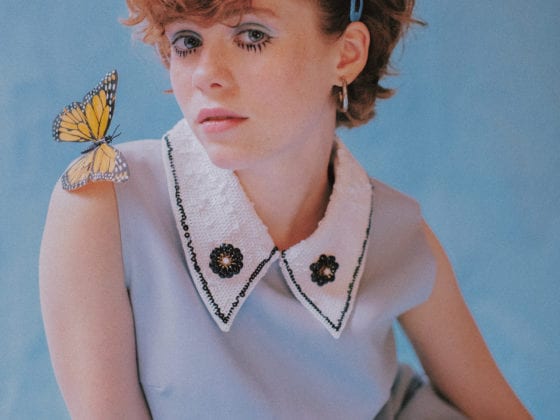




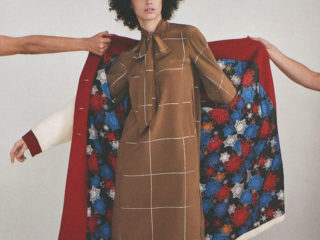
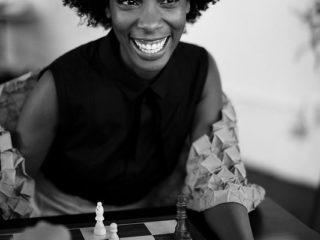
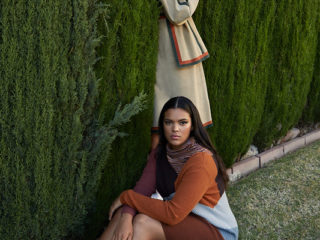
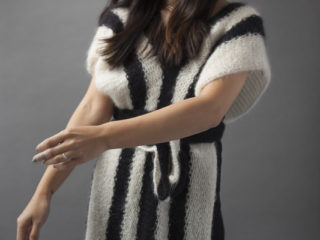

1 comment
I’ve been seeing this test everywhere lately! To me, it’s just another one of those personality tests… but it wouldn’t hurt to take it anyway, right? Like you said, they’re addictive! Thanks for the quick guide. 🙂
–
Charmaine Ng | Architecture & Lifestyle Blog
http://charmainenyw.com